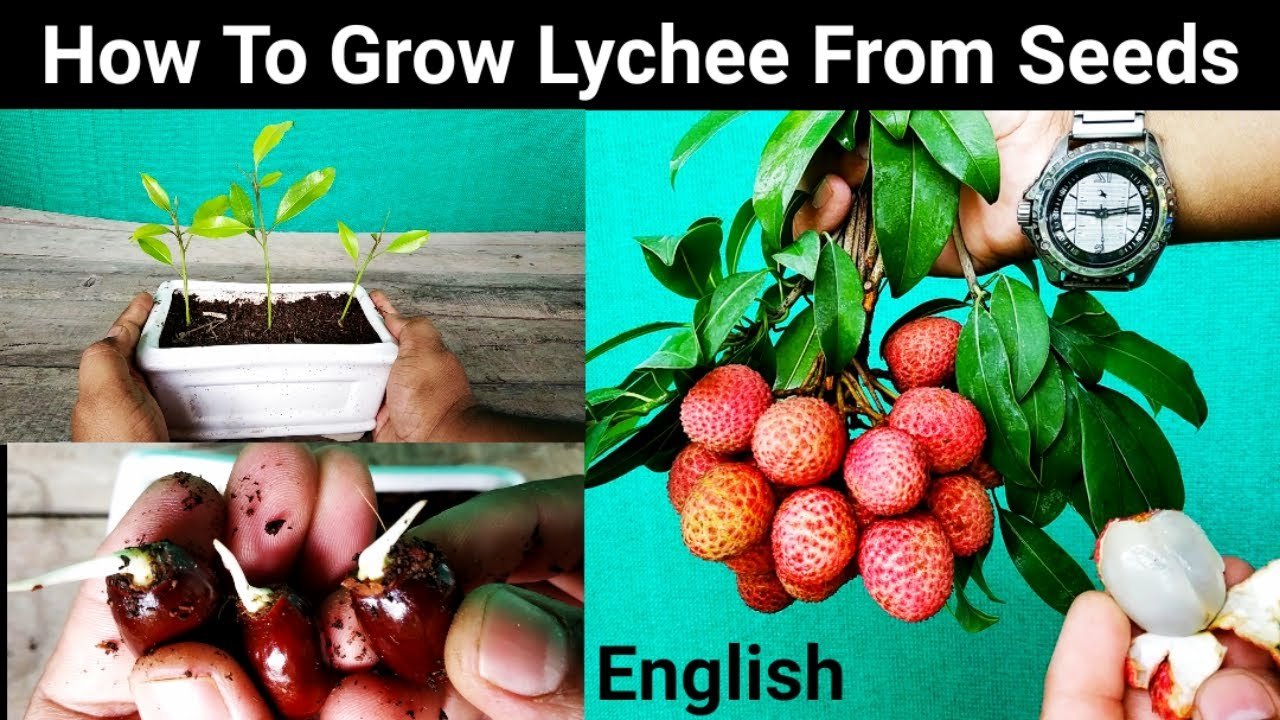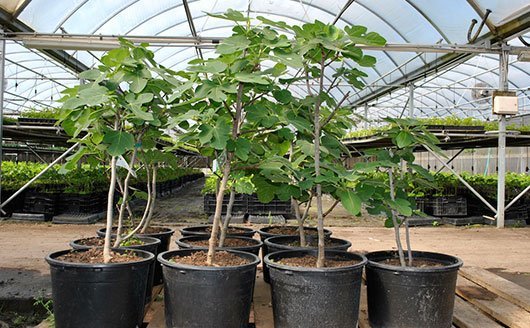how to grow lychee in a pot – [Beginners Guide]
If you’re looking for a unique and delicious fruit to grow at home, look no further than lychee! And the best part is, you don’t need a big garden or even a yard to do it. With a pot and a little bit of know-how, you can grow your own lychee tree right on your porch or balcony.
I first started growing lychee in pots a few years ago and was amazed at how well they thrived. Not only did I have a beautiful tree to admire, but I also enjoyed the sweet and exotic fruit it produced.
Growing lychee in a pot is a great option for many reasons. First and foremost, it allows those without access to a large garden or yard to still enjoy the benefits of growing their own produce. It’s also a great way to control the growing conditions, ensuring that your tree gets the right amount of sun, water, and nutrients. Plus, it’s a fun and rewarding hobby that can be enjoyed by gardeners of all levels of experience.
In this guide, we’ll walk through the steps of growing lychee in a pot, from choosing the right pot and soil to pruning and harvesting your fruit. We’ll also cover some common challenges and how to overcome them, so you can enjoy a successful harvest year after year.
So, if you’re ready to try your hand at growing lychee in a pot, let’s get started!
Pot or container selection
If you want to grow lychee in a pot at home, selecting the right pot is critical for the optimal growth of your tree. Here are some things to keep in mind when selecting a pot for your lychee:
Size and Capacity
Lychee trees can grow up to 30 feet tall, but when grown in a pot, they will remain smaller. However, they still require plenty of space to grow and produce fruit. For optimal growth, you should select a pot that is at least 20 inches (50 cm) in diameter and 20 inches (50 cm) deep. This size of the pot will allow your tree to spread its roots and grow to its full potential.
If you have limited space, you can choose a smaller pot, but be aware that this will limit the growth of your tree and reduce its yield. A smaller pot will also require more frequent watering and fertilization.
Construction
The construction of your pot is also important for the health of your lychee tree. Here are some things to consider:
- Material: Choose a pot made of a durable material, such as plastic, fiberglass, or glazed ceramic. Avoid unglazed terra cotta, as it can dry out quickly and cause stress to your tree’s roots.
- Drainage: Ensure that your pot has drainage holes in the bottom to allow excess water to drain out. This will prevent your tree’s roots from sitting in water, which can cause root rot.
- Size: A larger pot will provide better stability and insulation for your tree’s roots. It will also help to prevent the pot from tipping over during strong winds or storms.
By choosing a pot with the right size and construction, you can create an optimal growing environment for your lychee tree. This will give your tree the best chance at success and a bountiful harvest.
Make suitable soil mix
When it comes to growing lychee in pots, soil selection is just as important as pot selection. Lychee plants thrive in well-draining soil that is rich in organic matter. Here’s what you need to know about selecting the right soil mix for your lychee plants:
Type
It’s best to use a potting mix that is specifically formulated for acid-loving plants, such as azaleas or camellias. These mixes are typically made from a combination of peat moss, perlite or vermiculite, and pine bark. They are designed to be slightly acidic, which is ideal for lychee plants.
Avoid using garden soil or topsoil, as these types of soil may not have the right composition for container-grown plants. They may also contain weed seeds or pathogens that can harm your lychee plants.
Mixture
In addition to using a high-quality potting mix, you can add some amendments to your soil to give your lychee plants a boost. Here are some options:
- Compost: Adding compost to your soil can help improve its structure, drainage, and nutrient content.
- Organic fertilizers: You can use organic fertilizers, such as fish emulsion or bone meal, to provide additional nutrients for your plants.
- Epsom salt: Epsom salt can provide magnesium and sulfur, which are important nutrients for lychee plants.
- Sphagnum moss: Adding sphagnum moss to your soil mix can help improve its water-holding capacity and acidity level.
It’s important to remember that lychee plants are sensitive to over-fertilization, so it’s best to follow the package instructions when using any type of fertilizer. By choosing the right soil mix and adding the right amendments, you can give your lychee plants the best chance at success.
How to plant the lychee?
Growing lychee in a pot at home can be a rewarding experience. Here’s a step-by-step guide to help you get started:
Step 1: Choose the right pot
Select a pot that is large enough to accommodate the root system of your lychee plant. A pot with a diameter of at least 18 inches and a depth of at least 18 inches is a good size for most lychee trees. Make sure the pot has drainage holes to allow excess water to drain away from the roots.
Step 2: Fill the pot with soil
Fill the pot with a well-draining soil mix that is rich in organic matter. A good mix consists of 50% coarse sand or perlite, 30% well-rotted compost or organic matter, and 20% loamy soil. Make sure to leave enough space at the top of the pot for watering.
Step 3: Plant the lychee seedling
Remove the lychee seedling from its container, taking care to gently loosen the roots. Place the seedling in the center of the pot, making sure that the root ball is level with the soil surface. Fill in around the root ball with soil, gently tamping it down to remove any air pockets. Water the seedling well to help settle the soil around the roots.
Step 4: Mulch and support the plant
Add a layer of organic mulch around the base of the plant to help retain moisture in the soil and keep weeds at bay. If your lychee tree grows tall or produces heavy fruit, consider adding a stake or trellis to the pot to help support the plant. Be sure to place the stake or trellis in the pot before the plant grows too large.
Step 5: Water and fertilize
Lychee trees require regular watering to thrive. Water deeply once a week or as needed, making sure to soak the entire root ball. Avoid letting the soil dry out completely or become waterlogged. As the plant grows, you may want to fertilize it with a balanced, slow-release fertilizer to help it continue to thrive. Follow the instructions on the fertilizer package for the recommended amount and frequency.
With proper care and attention, your lychee tree will reward you with a bountiful harvest of delicious fruit.
How to care for lychee?
Watering Requirement
Lychee trees prefer a consistently moist soil but not one that is waterlogged. Water the plant deeply once or twice a week, depending on the weather and the size of the pot. Check the soil moisture level by sticking your finger about an inch into the soil. If it feels dry at that depth, it’s time to water.
Fertilizer Requirement
Lychee trees need regular fertilization to grow and produce fruit. Use a balanced fertilizer, such as a 8-8-8 or 10-10-10 formula, according to the package directions. Apply the fertilizer every two months during the growing season (spring and summer). Alternatively, you can use a slow-release fertilizer or organic compost to provide a steady supply of nutrients over time.
Sunlight Needs
Lychee trees need plenty of sunlight to thrive, so choose a spot in your home that gets at least 6 hours of direct sunlight per day. If you don’t have a sunny spot indoors, you can also grow lychee trees using a grow light.
Pruning & Training
Pruning and training lychee trees can help improve air circulation, increase sunlight exposure, and make harvesting easier. To prune, remove any dead, damaged, or diseased branches. Prune the tree in late winter or early spring before new growth appears. To train your lychee tree, use stakes or trellises to support the plant as it grows. This will help prevent it from falling over and will make it easier to access the fruit.
Other Care
In addition to watering, fertilizing, and pruning, there are a few other things you can do to care for your lychee tree:
- Provide humidity: Lychee trees thrive in a humid environment, so mist the leaves regularly or place a humidifier nearby.
- Protect from cold: Lychee trees are sensitive to cold temperatures, so keep the plant away from drafts or air conditioning vents during the winter.
- Be on the lookout for pests and diseases: Common pests include scale insects, spider mites, and mealybugs. Common diseases include anthracnose and brown rot. If you notice any issues, take action immediately to prevent them from spreading.
Remember that while lychee trees can be grown in pots, they may not produce fruit as abundantly as they would in their natural environment. With proper care, however, you can enjoy the unique beauty of this tree and perhaps even harvest some tasty lychee fruits.
Common problems
Other Issues
In addition to pests, insects, diseases, and poor production, cherry tomatoes grown in pots may also face other issues such as:
Root-bound plants: When the roots of the plant outgrow the pot, the plant becomes root-bound, which can stunt its growth and reduce its yield. To prevent this, make sure to choose a pot that is large enough for the plant and consider repotting it every 1-2 years.
Nutrient deficiencies: Cherry tomatoes grown in pots may be more susceptible to nutrient deficiencies due to the limited amount of soil and nutrients available. Symptoms of nutrient deficiencies include yellowing leaves, stunted growth, and poor fruit production. To prevent this, make sure to fertilize your plants regularly with a balanced fertilizer and consider adding compost to the soil.
Environmental stress: Cherry tomatoes grown in pots may be more vulnerable to environmental stress such as temperature fluctuations, drought, or excessive heat. To prevent this, make sure to provide your plants with adequate water and choose a location that is sheltered from extreme weather conditions.
By being aware of these common problems and taking appropriate measures to prevent and address them, you can enjoy a healthy and productive cherry tomato plant in your home garden.
Harvesting & storing homegrown lychee
Lychee trees generally produce fruit in the early summer, usually in May or June, depending on the climate and the variety. The fruit is ready to harvest when the skin turns from green to pink or red, and the spiky exterior becomes slightly raised. The fruit should also feel slightly soft to the touch. You can gently squeeze the fruit to check for ripeness, but be careful not to damage the delicate skin. If the fruit is still firm or hard, it is not yet ripe and should be left on the tree to mature.
To harvest the lychee fruit, simply twist and pull gently until the fruit separates from the stem. Be careful not to damage the surrounding fruit or branches. Once harvested, the fruit should be stored at room temperature and consumed as soon as possible for the best flavor and texture. Do not store lychee in the refrigerator, as this can cause the fruit to lose flavor and become dry.
If you have a large harvest and cannot consume all the fruit at once, you can freeze the lychee for later use. To do this, remove the skin and seed, and place the fruit in a resealable freezer bag. Store the bag in the freezer for up to six months. When ready to use, simply thaw the fruit in the refrigerator or at room temperature. Frozen lychee may lose some of its texture, but it can still be used in smoothies or other recipes.
Growing lychee in container – Conclusion
Congratulations on completing this guide on growing lychee in a pot! You should now have a good understanding of how to select the right pot and soil, plant and care for your lychee tree, and troubleshoot any common problems that may arise.
Growing lychee in a pot at home is a rewarding and enjoyable experience that allows you to enjoy the delicious fruits of your labor. With a little bit of patience and attention to detail, you can successfully grow lychee in a pot even if you have limited space or experience.
So why not give it a try? With the knowledge and skills you’ve gained from this guide, you can start your own lychee tree and enjoy the benefits of homegrown fruit. Remember to be patient, follow the care instructions, and don’t hesitate to seek advice if you encounter any issues. Happy gardening and enjoy your delicious homegrown lychee!







